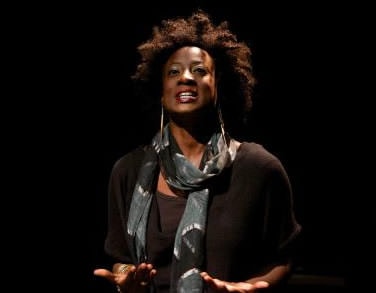How does one create a social movement? How does one create a community? How does one create a mecca for a movement and a community?
New play The Ashes Under Gait City by Christina Anderson concerns itself with such questions. You might not like the answers the play offers, but after seeing Ashes you will sure as hell be itching to debate the results.

The theory of social change through non-violence is rooted in a simple yet profound premise, and it does not have as much to do with marches on the Mall or speeches at the Lincoln Memorial as it does with provocation. Non-violent social change requires a provocation of moral outrage and a revelation of social dysfunction. The dominate forces of a society must be provoked into dropping their appearance of moral supremacy and, thus, revealing the true violence of their oppression. Water cannons must roar; gunfire must ring out; and happy citizens must reveal the brutality beneath their privilege.
Ms. Anderson’s fictional Gait City, Oregon, has a dark past beneath the heroic celebration of its identity. Over 150 years ago the city burnt to the ground; but the citizens rebuilt it from memory, a memory that purposely excluded the town’s African-American residents. Not 50 years ago they symbolically chased “a Negro” out of town. Now, they simply reenact the city’s all “white” renaissance.
The year is 2008. Simone the Believer comes to town determined to right the historic wrong. A wildly successful New Age Internet guru who uses her virtual identity to heal people of their self-doubt has a simple to-do list: 1) Find lodging, 2) Recruit allies, 3) Conquer the city, and 4) Establish Mecca. Any normal person would be overwhelmed by such a straightforward set of directives, but Simone is no normal person: she responds to doubt by simply asserting, “It’s doable.”
In other words, Ashes, despite its realistic veneer, is far more magical than not: it is more a New Age myth, or hoped for Urban Legend, than a tale grounded in the reality of contemporary America.
Daphne Gaines plays Simone the Believer with a delightful combination of sparkle and optimism, with the occasional razor-sharp streak of manipulation thrown in for effect. Though you might be tempted to declare her a charlatan, Ms. Gaines’s exuberant authenticity will stop you in your tracks.
Simone brings with her a young enthusiastic devotee named “D”, played smartly by Kaliswa Brewster. D is all wide-eyed follower, until she isn’t. For she is no wall flower pacifist ready to be led; she is all “A” type personality with a need for inner wisdom, the kind a Believer can affirm. When she recruits the idiosyncratic and lonely Jeremiah, using a combination of cuteness and assertive sexuality, she begins her transformation to second-in-command.
Played without complications by Biko Eise-Martin, Jeremiah is a long-time resident of the city and the group’s historical tour guide. He is also an unlikely convert to the cult of Simone, unlikely that is until he finds himself thoroughly immersed in D’s fiery glow.
An even less likely convert is the hardnosed, no nonsense Felicia, played with an engaging fierceness by Shauna Miles. It is her family’s ashes burned under Gait City, and it is her determination to resist the “bullshit” that makes her surrender to Simone the most difficult to pull off believably.
Director Lucie Tiberghien does an excellent job, however, navigating the difficult conversion of skeptics into followers, none more so that the gradual, step-by-step transformation of homeowner Felicia to warrior for Simone.
The one character that needs no transformation is Clay, played with an infectious enthusiasm by Willie C. Carpenter. He fell in love with Simone’s power when she was nothing more than a virtual presence.
Yes, a virtual presence, because a vital aspect of The Ashes Under Gait City is the making flesh and blood of a virtual presence. The design team does an excellent job bringing together Google’s world of video and text messages with warm embraces and real world brawls.
Set Designer Luciana Stecconi creates a visualscape that resembles an Internet world while Matthew Haber’s projections work wonderfully—I’m sure with great aid from Video Engineer Geoff Moore. Costume Designer Devon Painter adds depth and context to the characters, while Lighting Designer Tony Galaska keeps the action moving and the spaces fluid: perhaps, as moving as the spaces on the Internet.

The Ashes Under Gait City has a compelling story that is sure to stimulate a good deal of talk, no matter what your race or family background. As cities gentrify and rundown neighborhoods are rebuilt for the moneyed and upwardly mobile; and poor people, or poor black people, are removed from the geography and replaced on the tax rolls by wealthier counterparts, questions of space and memory stir.
Who will be erased? Who will be rendered invisible? But, more importantly, what will those unseen forces do to bring themselves back into the light?
Running Time: 90 minutes without an intermission.
The Ashes Under Gait City and The Contemporary American Theater Festival (CATF) continue through August 3, 2004. Performance tickets to CATF can be purchased through the Theater Festival Box Office, Monday to Friday from 11 am to 5 pm, by calling (800) 999-CATF (2283), or by purchasing them online.
Learn more about the plays, and/or look at the full schedule.
LINKS
The Playwright’s Playground: ‘The Playmakers – CATF 2014: Interview With Ed Herendeen & Peggy McKowen Who Preview The Season by Sydney-Chanele Dawkins.
The Playwright’s Playground: The Playmakers CATF 2014: Ed Herendeen & Peggy McKowen Discuss the Development of CATF Plays by Sydney-Chanele Dawkins.




